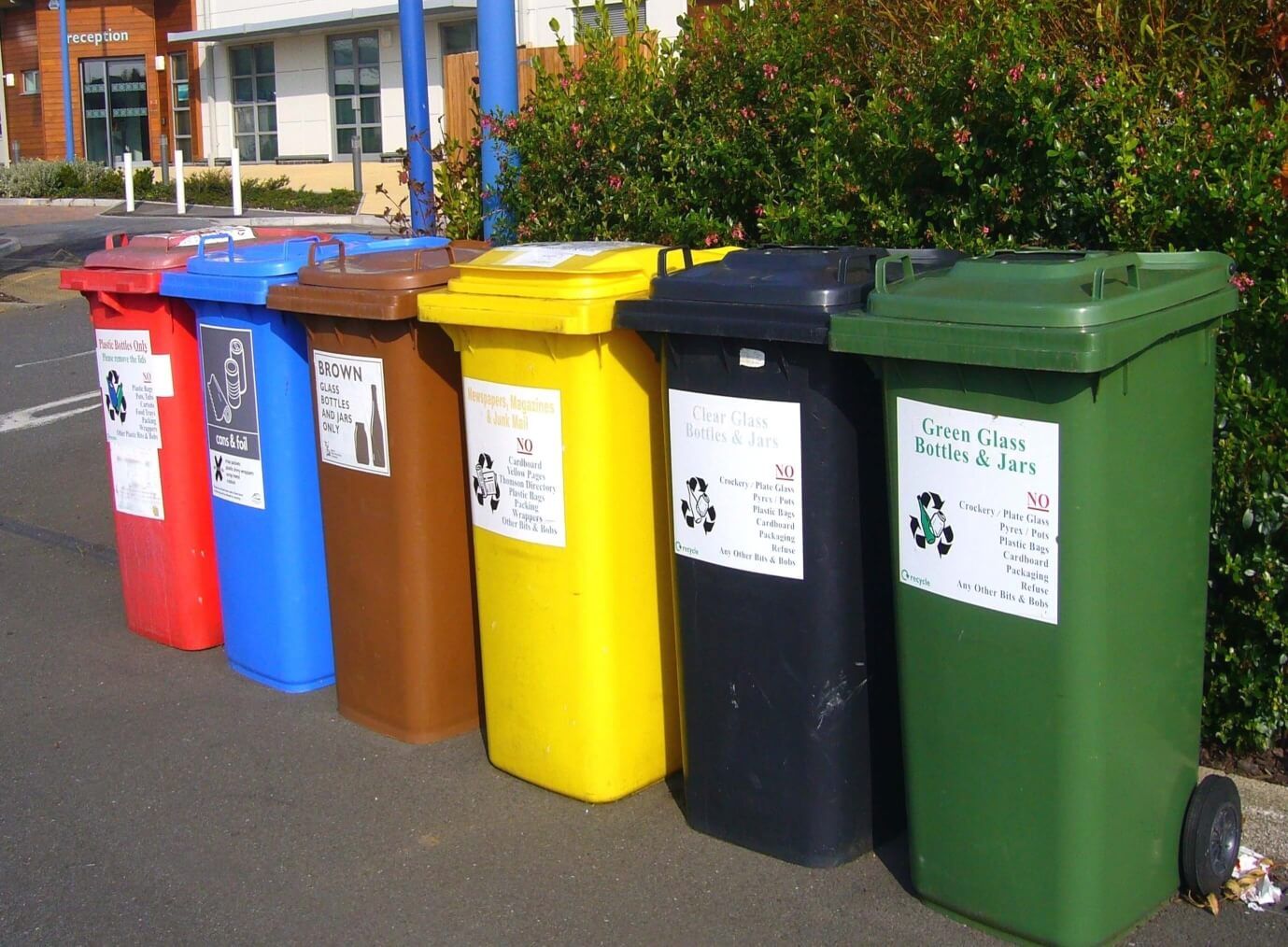Fact – Based on 2017 data, the average waste of a person in the UK is just over 400kg a year; whilst a study by the University of Sussex found that the average family in the UK throws away 20% of all the food they buy, costing up to £800 a year. See the BBC article below:
Where does our recycling and rubbish go?
It’s easy to congratulate ourselves as we fill our recycle bins with our daily waste and drive to the local recycling centre with our broken or unwanted larger items, but all said and done, it’s still waste.
We also have a problem in that although it is possible for most of our waste* to be recycled, existing facilities can only recycle certain types of waste. The rest may end up being incinerated** or ending up in landfill. This includes many items that could be reused, refurbished, repaired, upcycled or even composted!
We should therefore make an extra effort to modify our buying habits and also how we treat our waste.
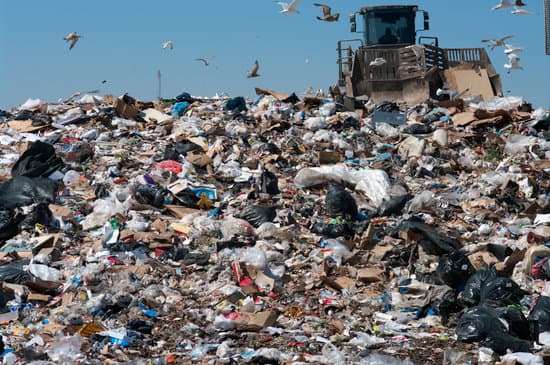
*Residents in Greater Manchester can use the handy A-Z guide to help you recycle and dispose of your waste safely.
**Many people buy into the idea that incinerators are a good way of producing energy compared to the alternatives. Before moving on from this part of the section, it might be worth reading the gaia article by Paul Connett, PhD who passionately believes that waste incineration is a very bad idea.
Okay, let’s now look at how we can reduce or better still recycle the different waste types that we create:
♦ Food
As far as food is concerned, aim to buy it without any form of packaging and avoid costly convenience meals. Buying smaller quantities of loose fresh fruit, veg and other food on a regular basis will cut down the chances of overbuying, and reduce not only your food waste but also the packaging.
Over a year you should in theory save a substantial amount of money, but you do have to bear in mind that supermarkets often charge more for loose food compared to their packaged equivalent.
Shopping in local shops such as bakers, cheesemongers and greengrocers is usually the better option, as more of the food is sold loosely or uses less packaging than that bought in a supermarket. Additionally, it’s more likely that the produce has been locally sourced.
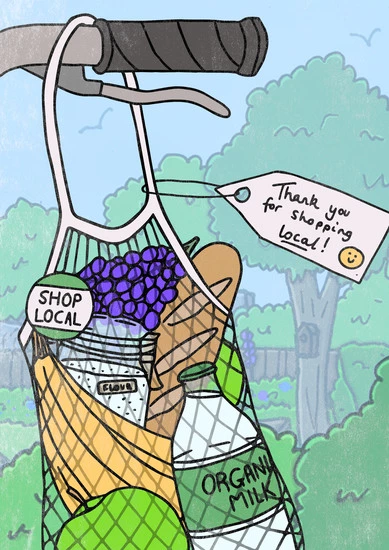
Where you have an option to buy loose food, try to avoid using the shop’s free produce bags. If you don’t have a suitable bag, they may be available to purchase in the shop or from an online store such as these award winning lightweight recycled produce bags. They are specially made for fruit and veg and other produce that requires weighing.
After taking your fresh food home, you need to consider how long it can be stored for. Remember that flavours and health benefits can be reduced if fresh food is stored for too long. It can also go off.
To reduce the possibility of waste, plan ahead and where appropriate, cook meals for sticking in the freezer to eat at a later date. Pickling and fermenting food is also another option.
Despite your best efforts, you will still have some food waste. This may be just stalks, leaves or pips that are considered edible but you can’t bring yourself to eat in any form. It could be rotten food unnoticed at the time of purchase. There are lots of reasons, so now we have to decide what to do with it.
Many Local Authorities provide food caddy bins, and waste food placed here will be composted at a local recycling centre. To make the compost more balanced, additional ingredients such as wood chips and garden waste will be added and the resultant compost sold on for commercial use.
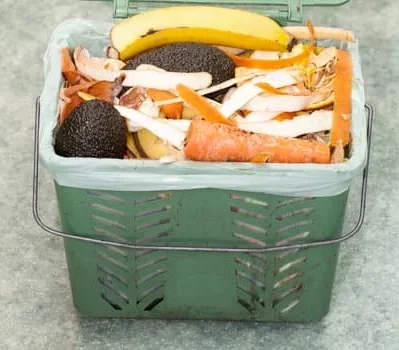
You can also compost food waste at home. There are many composting systems out there, including indoor systems such as Bokashi.
Inevitably you will also have packaging to sort out and more so if you buy a lot of convenience foods. The packaging will include cardboard and various types of plastics, which may or may not be recyclable and will depend on your local council’s recycling facilities.
If you have to buy convenience food, look out meals with compostable* packaging. More and more manufacturers are now looking at ways to package food with compostable materials, although there is some way to go before this packaging type is widely available.
*If the packaging says it is home compostable, it can be added to your compost bin or heap and will be easily compostable along with your other food scraps, grass cuttings and twigs etc.
If the packaging says it is commercially compostable, it requires a more constant high temperature and regular turning to make it into useful compost. Usually only industrial sized compost facilities can make this possible.
♦ Clothing
There comes a time when your clothes, shoes and other fabric items (such as bed linen), are of no use to you. Repairs may not be an option because of either cost or the state they are in. Clothes may not fit you anymore or in fact you just want rid.
However, that doesn’t mean that they should just be thrown out. First, consider whether you can upcycle them. From bags to puppets, there are lots of ideas out there. Take a look at the inspirational ‘love your clothes’ website.
A little earlier in the section we mentioned that clothes and accessories can be purchased through online stores such as ‘preloved’. You can also sell your clothes and accessories through these same stores.
If you don’t have the time or inclination to sell your clothes, then local and national charities will happily accept items in a reasonable condition. Clothing Banks are also situated in many towns and cities and will take a wide range of clothes or shoes.
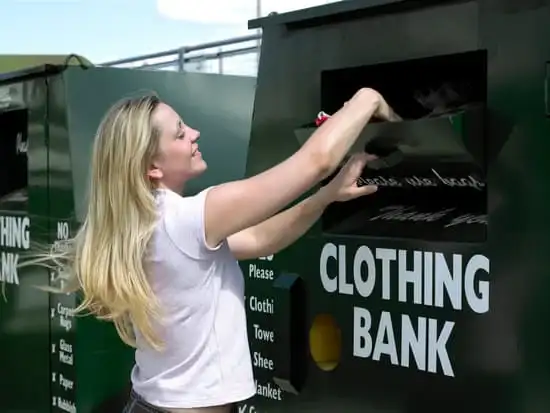
If you are unsure whether a charity will accept your clothes or other fabric items, consider donating them to the national charity Oxfam. They guarantee a use for any clothing or textile item (including shoes) no matter what the condition.
Also don’t forget that clothes made solely with natural fibres such as cotton and wool can be composted; but as the fibres are strong and are likely to take a long time to compost, shredding as much as possible will help.
Note: There is a concern that some dyes used in the production of clothing can be harmful to the environment and in theory, compost from clothes used for growing food, can have a detrimental effect on your fruit or vegetables.
♦ Cleaning, Laundry and General Maintenance Products
Although most cleaning and laundry items use plastic packaging, products such as perfumes, furniture polish, solvents and paints may come in glass or metal containers. Recycling some plastics can be a problem and will depend on your local council’s facilities, whilst glass or metal items can usually be easily recycled. Some waste is classed as hazardous* and should be taken to your local recycling centre rather than placed in your usual recycling bins.
Disposable products such as floor wipes should be disposed of in your general waste bin. This includes so called flushable ones as they can contribute to fatbergs before biodegrading. Paper kitchen towels and similar can be composted if they have not been chlorine-bleached (to make them look whiter).
If you are unsure whether an item can be recycled, contact your local council recycling centre (either by phone or email). Most council websites also have a section on local recycling facilities.
Another option available in some shops is being able to refill bottles or containers with washing up or laundry liquids, shampoos, and soaps. The choices are minimal, but you do tend to find that what is available is more environmentally friendly.
♦ Furniture, Appliances, IT Equipment and Broken or Unwanted Stuff
When buying new furniture or appliances, you often find that the packaging is excessive. The manufacturer’s argument is that it is there to protect their products from damage occurring during transit. Whilst this is true to a large extent, there can be no excuse in trying to source more environmentally friendly packaging.
As consumers we should do our best to recycle any packaging as best we can; but prior to any purchase, it might be an idea to carry out some research into the company’s ethics. The highest rated tend to at least consider more sustainable packaging and are less likely to be wasteful in other areas. Ethical Consumer magazine supplies ratings for many companies.
Don’t forget that buying second hand can be a good option, and in particular good quality furniture can be bought for a very reasonable cost. Older appliances though, are likely to cost more in energy usage compared to newer models and may also turn out to be unreliable.
From time to time you will have items that are broken or unwanted. For broken items, check out whether they can be locally repaired, rather than disposing of them at your local recycling centre.
Community repair shops run by volunteers are another option. They may only open a couple of times a month or perhaps even less, and although there is no guarantee that a fix is possible, assistance is given to help you repair your item.
The ‘rethinking poverty’ blog gives an outline of what a community repair shop is and also supplies the names of a few that are located in Greater Manchester.
For unwanted stuff consider donating them to a local charity or passing them on for free to family, friends and neighbours. The online sites ‘freecycle’ and ‘freegle’ are also another way of giving away items for free.
Food banks are another option. Besides food donations, they also accept personal and general household items. The Walesonline article takes a look at other items that may be as important as food donations.
There are also many ways to sell your items. Examples include Car Boot Sales, Gumtree and EBay. Cash raised could fund your green living ideas.
Do remember though that IT items such as computers or monitors may contain sensitive information and hazardous materials. Your local recycling centre will probably be able to take most of the items.
The alternative option is to contact a specialist organisation that may collect your equipment for free and securely destroy any data that remains. Many items can be refurbished and are appreciated by charities or other community organisations.

Through the website links listed below, you should be able to arrange collections for not only your IT equipment but also many other electrical items:
1. A wide range of electrical equipment – Weee Charity
2. Computer and similar equipment – Smart Tech Recycling
3. Computer and Waste Electrical Equipment – UK I.T. Recycling
*Hazardous Materials
There are some types of items or materials that may not be recycled at your local recycling centre, or even one of the specialised types of companies mentioned just above. These include medicines and waste fuel. To get more of an idea of what hazardous materials can’t be recycled and who to contact for safe disposal, check out the informative Conwy County Borough Council’s website.
♦ Junk Mail
According to Veolia over 17.5 billion pieces of junk mail are produced and distributed each year in the UK. That’s a lot of stuff we don’t want to read and an utter waste of scarce resources.
By doing something about it, we will save a lot of trees, help wildlife and save on production costs…what a great way to help the environment.
Luckily, there are some fairly easy ways to cut down on junk mail. Have a look at the Citizens Advice website for suggestions on how to do this.
♦ Composting
It is to be expected that your regular refuse service has provision for collecting not only your kitchen waste but also grass cuttings, leaf fall and twigs from the garden if you have one.
If not, there are various types of composters that can turn your waste into compost and be used to provide nutrients for our plants, trees and fruit and vegetables if you grow them.
If composting is of any interest to you, then check out our Wildlife Gardening section for more information.

